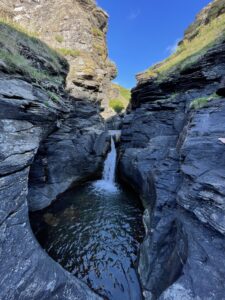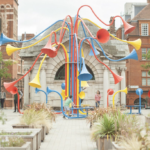Using our sense of touch to engage directly with nature has been linked to health restoration, improved wellbeing and an increased emotional connectedness to nature (Rickard & White, 2021). This blog will explore the therapeutic effects of ‘touching nature’ while participating in wild swimming during the Covid-19 pandemic, and how this can forge a stronger relationship with the natural environment.
As Covid-19 restrictions were put in place, physical interactions between people were prohibited and so connecting with nature became an important mechanism for coping with the uncertainty and fear of the pandemic (Doughty, Hu and Smit, 2023). Recent research has highlighted the therapeutic benefits of green, blue and brown spaces, which enabled a wide range of rejuvenating physical and mental activities during the pandemic, creating positive experiences for healing and health (Bates & Moles, 2022).
The wellbeing benefits of wild swimming are not new, having been extensively researched, but it grew in popularity during the pandemic (Bates & Moles, 2023). It is also increasingly seen as something “inherently exciting, addictively intoxicating and suitably escapist” (Gould, McLachlan and McDonald, 2021, p.41). Prior to the pandemic, I had little experience of natural aquatic environments other than the seaside. I had no appreciation of the therapeutic benefits I would eventually reap in freshwater blue spaces. For some, wild swimming creates an excitement of conquering fears, controlling the mind and body under extreme temperatures, while for others it’s socialising with other swimmers while doing physical exercise (Bates & Moles, 2023). For me, it was usually a solitary endeavour, with the focus being on myself and my relationship with the natural environment. It was less about the act of swimming and more about immersing myself in the cold water and experiencing the haptic sensations flowing over and through my body. Submerging into the water triggered something extraordinary in my psychological state and connection with nature.

Touch, of all of our senses, has the ability to dissolve the boundaries between our bodies and the natural environment, and is seen as fundamental in helping build meaningful and intimate relationships with nature (Bates & Moles, 2023). In feeling the slippery algae on the rocks, the warmer skin layer of water on my floating arms or the brush of aquatic plants across my legs, I felt closely connected to the environment. Throsby (2013) highlights the role that resistance and buoyancy add to the direct haptic experience which stimulates “unconscious physiological restoration effects” (Rickard & White, 2021, p.976). It was through such haptic experiences that tangible and strong material and emotional connections were made with my natural environment. I felt part of, and at one with, the natural world, and this intimate relationship became increasingly important for my wellbeing and mental resilience during lockdown.

Engaging in wild swimming can replicate a similar sense of conviviality and fulfilment that people receive in the presence of loved ones (Straughan, 2012). Research has found that immersing oneself in nature heightens the sensory experience of the natural environment, creating a deeper sense of belonging to nature (Bates & Moles, 2023). Being in freshwater filled the absence of human touch. Once fully submerged and acclimatised, my ability to relax was restored by nature and with this came a new appreciation and increased respect for the natural world.
Word count: 508
References:







